mitsubishi MDS-C1-SPA Instruction Manual
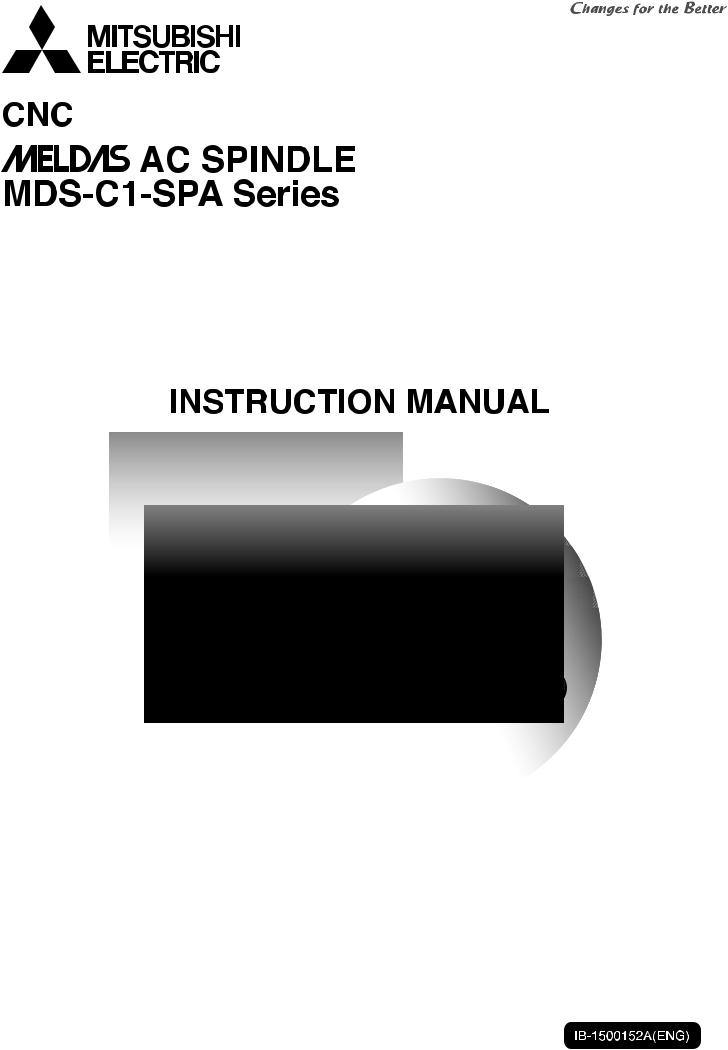
MELDAS is a registered trademark of Mitsubishi Electric Corporation.
Other company and product names that appear in this manual are trademarks or registered trademarks of their respective companies.
Introduction
Thank you for selecting the Mitsubishi numerical control unit.
This instruction manual describes the handling and caution points for using this AC servo/spindle.
Incorrect handling may lead to unforeseen accidents, so always read this instruction manual thoroughly to ensure correct usage.
Make sure that this instruction manual is delivered to the end user.
Always store this manual in a safe place.
All specifications for the MDS-C1-SPA Series are described in this manual. However, each CNC may not be provided with all specifications, so refer to the specifications for the CNC on hand before starting use.
Notes on Reading This Manual
(1)Since the description of this specification manual deals with NC in general, for the specifications of individual machine tools, refer to the manuals issued by the respective machine manufacturers. The "restrictions" and "available functions" described in the manuals issued by the machine manufacturers have precedence to those in this manual.
(2)This manual describes as many special operations as possible, but it should be kept in mind that items not mentioned in this manual cannot be performed.
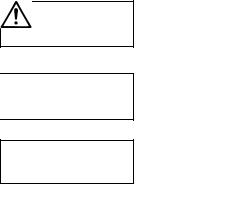
Precautions for safety
Please read this manual and auxiliary documents before starting installation, operation, maintenance or inspection to ensure correct usage. Thoroughly understand the device, safety information and precautions before starting operation.
The safety precautions in this instruction manual are ranked as "WARNING" and "CAUTION".
DANGER

 WARNING
WARNING
CAUTION
When there is a potential risk of fatal or serious injuries if handling is mistaken.
When operator could be fatally or seriously injured if handling is mistaken.
When a dangerous situation may occur if handling is mistaken leading to medium or minor injuries, or physical damage.
Note that some items described as |
|
|
CAUTION |
may lead to major results depending on |
|
|
|||
|
|
|
|
|
the situation. In any case, important information that must be observed is described.
The numeric control unit is configured of the control unit, operation board, servo drive unit, spindle drive unit, power supply unit, servomotor and spindle motor, etc.
In this section "Precautions for safety", the following items are generically called the "servomotor".
•Servomotor
•Spindle motor
In this section "Precautions for safety", the following items are generically called the "servo drive unit".
•Servo drive unit
•Spindle drive unit
•Power supply unit
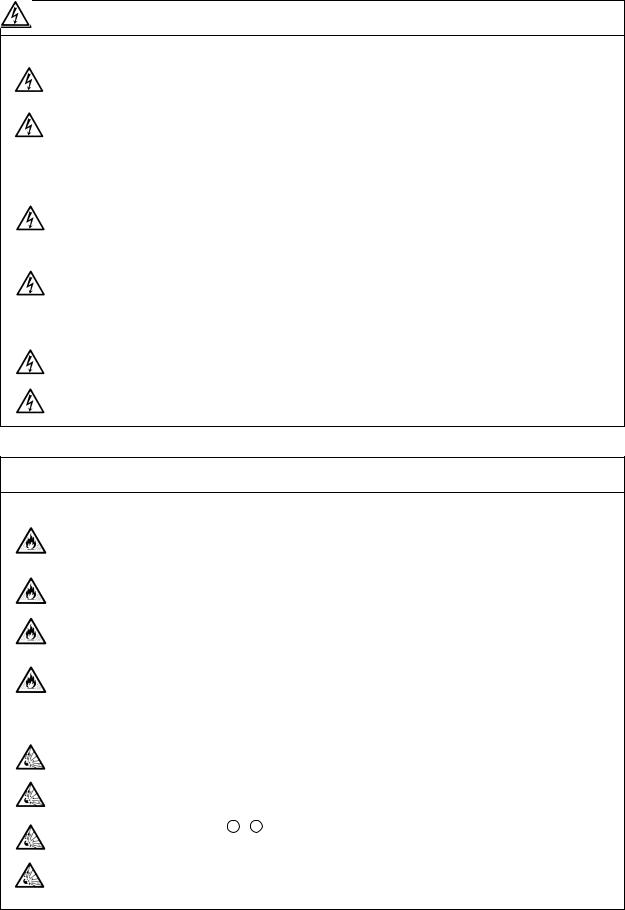
 WARNING
WARNING
1. Electric shock prevention
Do not open the front cover while the power is ON or during operation. Failure to observe this could lead to electric shocks.
Do not operate the unit with the front cover removed. The high voltage terminals and charged sections will be exposed, and can cause electric shocks.
Do not remove the front cover even when the power is OFF unless carrying out wiring work or periodic inspections. The inside of the units is charged, and can cause electric shocks.
Wait at least 15 minutes after turning the power OFF before starting wiring, maintenance or inspections. Failure to observe this could lead to electric shocks.
Ground the servo drive unit and servomotor with Class C (former class 3) grounding or higher.
Wiring, maintenance and inspection work must be done by a qualified technician.
Wire the servo drive unit and servomotor after installation. Failure to observe this could lead to electric shocks.
Do not touch the switches with wet hands. Failure to observe this could lead to electric shocks.
Do not damage, apply forcible stress, place heavy items on the cables or get them caught. Failure to observe this could lead to electric shocks.
CAUTION
1. Fire prevention
Install the servo drive units, servomotors and regenerative resistor on noncombustible material. Direct installation on combustible material or near combustible materials could lead to fires.
Shut off the power on the servo drive unit side if the servo drive unit fails. Fires could be caused if a large current continues to flow.
When using a regenerative resistor, provide a sequence that shuts off the power with the regenerative resistor's error signal. The regenerative resistor could abnormally overheat and cause a fire due to a fault in the regenerative transistor, etc.
The battery unit could heat up, ignite or rupture if submerged in water, or if the poles are incorrectly wired.
2. Injury prevention
Do not apply a voltage other than that specified in Instruction Manual on each terminal. Failure to observe this item could lead to ruptures or damage, etc.
Do not mistake the terminal connections. Failure to observe this item could lead to ruptures or damage, etc.
Do not mistake the polarity ( + , – ). Failure to observe this item could lead to ruptures or damage, etc.
The servo drive unit's fins, regenerative resistor and servomotor, etc., may reach high temperatures while the power is ON, and may remain hot for some time after the power is turned OFF. Touching these parts could result in burns.
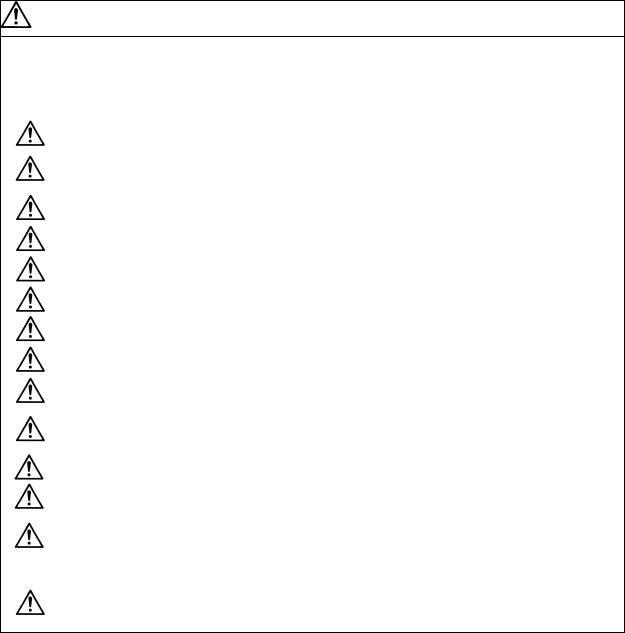
CAUTION
3. Various precautions
Observe the following precautions. Incorrect handling of the unit could lead to faults, injuries and electric shocks, etc.
(1) Transportation and installation
Correctly transport the product according to its weight.
Use the servomotor's hanging bolts only when transporting the servomotor. Do not transport the servomotor when it is installed on the machine.
Do not stack the products above the tolerable number.
Do not hold the cables, axis or detector when transporting the servomotor.
Do not hold the connected wires or cables when transporting the servo drive units.
Do not hold the front cover when transporting the servo drive units. The unit could drop.
Follow this Instruction Manual and install in a place where the weight can be borne.
Do not get on top of or place heavy objects on the unit.
Always observe the installation directions.
Secure the specified distance between the servo drive unit and control panel's inner wall, and between other devices.
Do not install or run a servo drive unit or servomotor that is damaged or missing parts.
Do not block the intake or exhaust ports of the servomotor provided with a cooling fan.
Do not let foreign objects enter the servo drive units or servomotors. In particular, if conductive objects such as screws or metal chips, etc., or combustible materials such as oil enter, rupture or breakage could occur.
The servo drive units and servomotors are precision devices, so do not drop them or apply strong impacts to them.
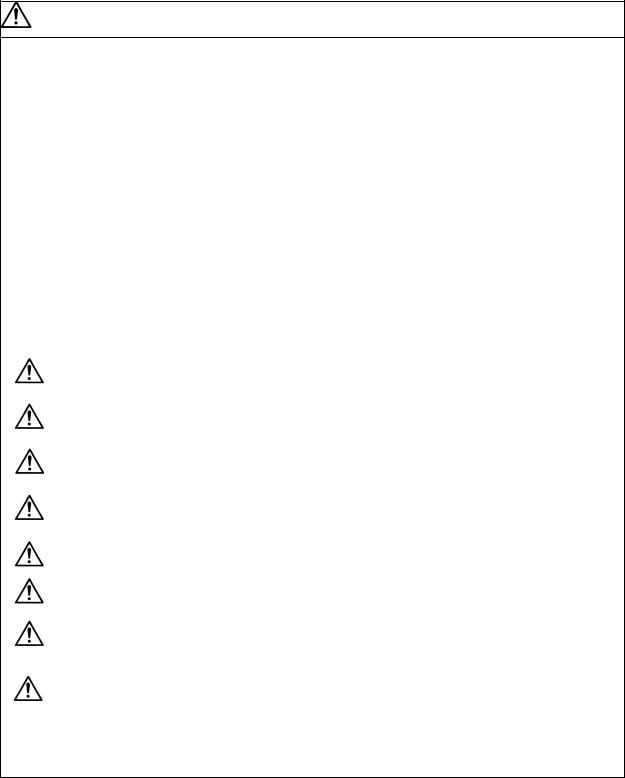
CAUTION
 Store and use the units under the following environment conditions.
Store and use the units under the following environment conditions.
Environment |
Conditions |
||
Servo drive unit |
Servomotor |
||
|
|||
Ambient temperature |
0°C to +55°C (with no freezing) |
0°C to +40°C (with no freezing) |
|
Ambient humidity |
90%RH or less |
80% RH or less |
|
(with no dew condensation) |
(with no dew condensation) |
||
|
|||
Storage temperature |
-15°C to +70°C |
||
Storage humidity |
90%RH or less (with no dew condensation) |
||
Atmosphere |
Indoors (where unit is not subject to direct sunlight), |
||
with no corrosive gas, combustible gas, oil mist, |
|||
|
dust or conductive particles |
||
Altitude |
1,000m or less above sea level |
||
Vibration |
4.9m/s2 (0.5G) or less |
To follow each unit and motor |
|
|
|
specifications |
|
Securely fix the servomotor to the machine. Insufficient fixing could lead to the servomotor slipping off during operation.
Always install the servomotor with reduction gear in the designated direction. Failure to do so could lead to oil leaks.
Structure the rotary sections of the motor so that it can never be touched during operation. Install a cover, etc., on the shaft.
When installing a coupling to a servomotor shaft end, do not apply an impact by hammering, etc. The detector could be damaged.
Do not apply a load exceeding the tolerable load onto the servomotor shaft. The shaft could break.
Store the motor in the package box.
When inserting the shaft into the built-in IPM motor, do not heat the rotor higher than 130°C. The magnet could be demagnetized, and the specifications characteristics will not be ensured.
If the unit has been stored for a long time, always check the operation before starting actual operation. Please contact the Service Center or Service Station.
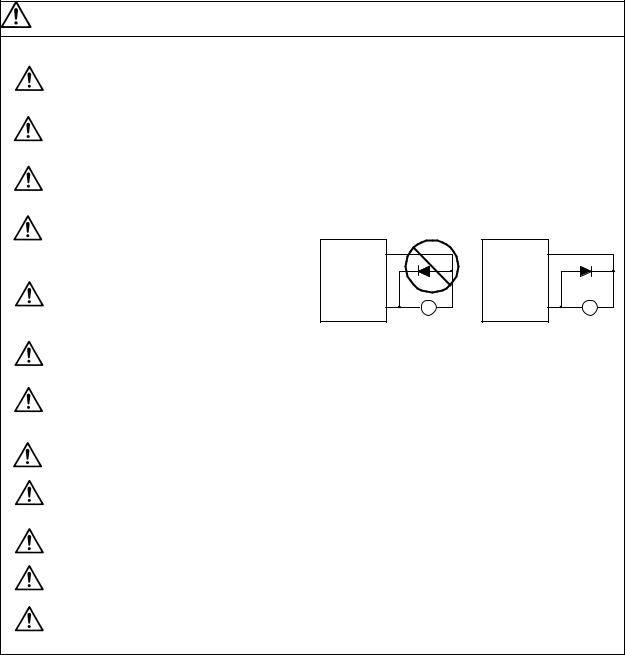
CAUTION
(2) Wiring
Correctly and securely perform the wiring. Failure to do so could lead to runaway of the servomotor.
Do not install a condensing capacitor, surge absorber or radio noise filter on the output side of the servo drive unit.
Correctly connect the output side (terminals U, V, W). Failure to do so could lead to abnormal operation of the servomotor.
Do not directly connect a commercial power supply to the servomotor. Failure to observe this could result in a fault.
When using an inductive load such as a relay, always connect a diode as a noise measure parallel to the load.
Servodrive unit
COM |
|
|
(24VDC) |
|
|
Control output |
RA |
|
signal |
||
|
Servodrive unit |
|
|
COM |
|
|
(24VDC) |
|
|
Control output |
RA |
|
signal |
||
|
When using a capacitance load such as a lamp, always connect a protective resistor as a noise measure serial to the load.
Do not reverse the direction of a diode which connect to a DC relay for the control output signals to suppress a surge. Connecting it backwards could cause the drive unit to malfunction so that signals are not output, and emergency stop and other safety circuits are inoperable.
Do not connect/disconnect the cables connected between the units while the power is ON.
Securely tighten the cable connector fixing screw or fixing mechanism. An insecure fixing could cause the cable to fall off while the power is ON.
When using a shielded cable instructed in the connection manual, always ground the cable with a cable clamp, etc.
Always separate the signals wires from the drive wire and power line.
Use wires and cables that have a wire diameter, heat resistance and flexibility that conforms to the system.
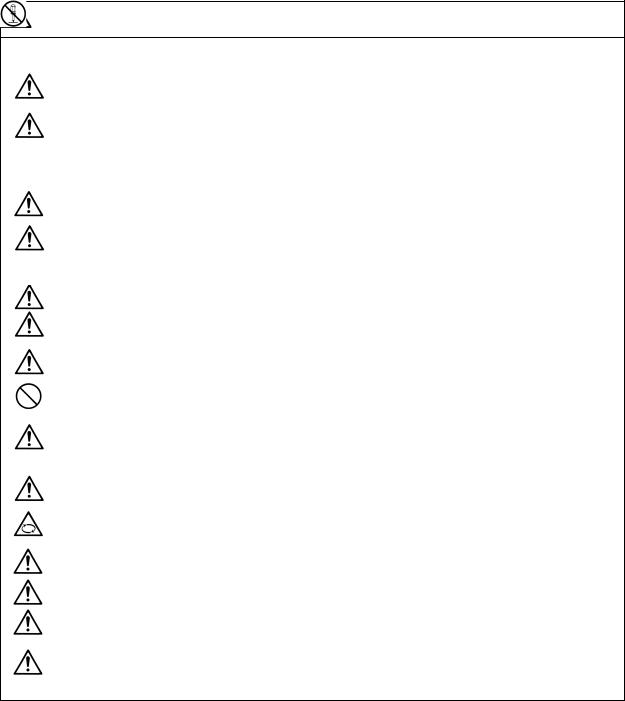
CAUTION
(3) Trial operation and adjustment
Check and adjust each program and parameter before starting operation. Failure to do so could lead to unforeseen operation of the machine.
Do not make remarkable adjustments and changes as the operation could become unstable.
(4) Usage methods
Install an external emergency stop circuit so that the operation can be stopped and power shut off immediately.
Turn the power OFF immediately if smoke, abnormal noise or odors are generated from the servo drive unit or servomotor.
Unqualified persons must not disassemble or repair the unit. Never make modifications.
Reduce magnetic damage by installing a noise filter. The electronic devices used near the servo drive unit could be affected by magnetic noise.
Use the servo drive unit, servomotor and regenerative resistor with the designated combination. Failure to do so could lead to fires or trouble.
The brake (magnetic brake) assembled into the servomotor is for holding, and must not be used for normal braking.
There may be cases when holding is not possible due to the magnetic brake's life or the machine construction (when ball screw and servomotor are coupled via a timing belt, etc.). Install a stop device to ensure safety on the machine side.
After changing the programs/parameters or after maintenance and inspection, always test the operation before starting actual operation.
Do not enter the movable range of the machine during automatic operation. Never place body parts near or touch the spindle during rotation.
Follow the power supply specification conditions given in the separate specifications manual for the power (input voltage, input frequency, tolerable sudden power failure time, etc.).
Set all bits to "0" if they are indicated as not used or empty in the explanation on the bits.
Do not use the dynamic brakes except during the emergency stop. Continued use of the dynamic brakes could result in brake damage.
If a breaker is shared by several power supply units, the breaker may not activate when a short-circuit fault occurs in a small capacity unit. This is dangerous, so never share the breakers.
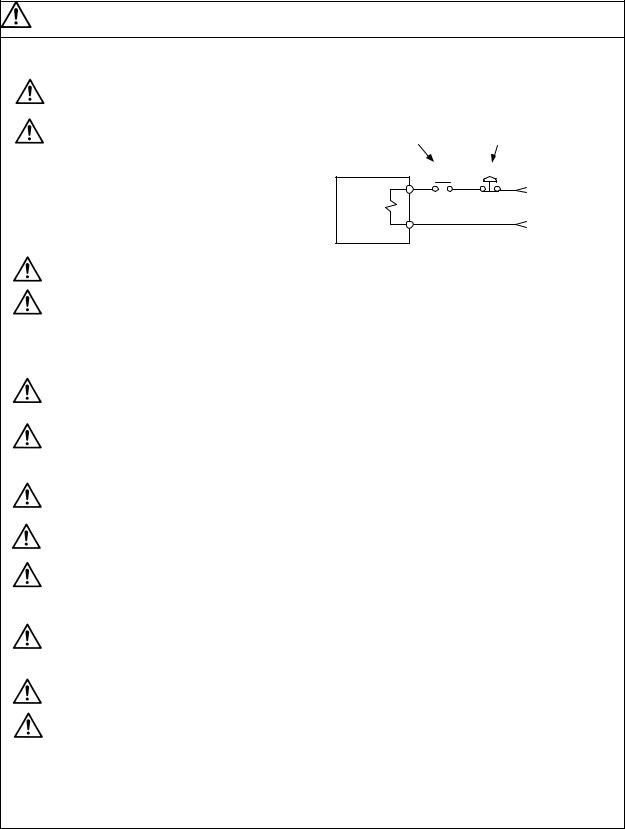
CAUTION
(5) Troubleshooting
If a hazardous situation is predicted during power failure or product trouble, use a servomotor with magnetic brakes or install an external brake mechanism.
Use a double circuit configuration that allows the operation circuit for the magnetic brakes to be operated even by the external emergency stop signal.
Shut off with the servomotor brake control output.
Servomotor MBR
Magnetic brake
Shut off with NC brake control PLC output.
EMG
24VDC
Always turn the input power OFF when an alarm occurs.
Never go near the machine after restoring the power after a power failure, as the machine could start suddenly. (Design the machine so that personal safety can be ensured even if the machine starts suddenly.)
(6) Maintenance, inspection and part replacement
Always carry out maintenance and inspection after backing up the servo drive unit's programs or parameters.
The capacity of the electrolytic capacitor will drop over time. To prevent secondary disasters due to failures, replacing this part every five years when used under a normal environment is recommended. Contact the Service Center or Service Station for replacement.
Do not perform a megger test (insulation resistance measurement) during inspections.
If the battery low warning is issued, save the machining programs, tool data and parameters with an input/output unit, and then replace the battery.
Do not short circuit, charge, overheat, incinerate or disassemble the battery.
(7) Disposal
Treat this unit as general industrial waste. Note that MDS Series unit with a heat dissipating fin protruding from the back of the unit contains substitute Freon. Do not dispose of this type of unit as general industrial waste. Always return to the Service Center or Service Station.
Do not disassemble the servo drive unit or servomotor parts.
Dispose of the battery according to local laws.
(8) General precautions
The drawings given in this Specifications and Maintenance Instruction Manual show the covers and safety partitions, etc., removed to provide a clearer explanation. Always return the covers or partitions to their respective places before starting operation, and always follow the instructions given in this manual.
|
|
CONTENTS |
|
1. Installation |
|
||
1-1 Installation of spindle motor................................................................................................. |
1-2 |
||
1-1-1 |
Environmental conditions .............................................................................................. |
1-2 |
|
1-1-2 |
Shaft characteristics ...................................................................................................... |
1-2 |
|
1-2 Installation of the control unit............................................................................................... |
1-3 |
||
1-2-1 |
Environmental conditions .............................................................................................. |
1-3 |
|
1-2-2 Installation direction and clearance............................................................................... |
1-4 |
||
1-2-3 Prevention of entering of foreign matter........................................................................ |
1-4 |
||
1-2-4 Panel installation hole work drawings (Panel cut drawings)......................................... |
1-5 |
||
1-2-5 |
Heating value................................................................................................................. |
1-6 |
|
1-2-6 |
Heat radiation countermeasures ................................................................................... |
1-7 |
|
1-3 Installing the spindle detector .............................................................................................. |
1-9 |
||
1-3-1 |
Magnetic sensor ............................................................................................................ |
1-9 |
|
1-3-2 |
Spindle side detector ................................................................................................... |
1-11 |
|
1-4 |
Noise measures................................................................................................................. |
1-12 |
|
2. Wiring and Connection |
|
||
2-1 |
Connection diagram............................................................................................................. |
2-3 |
|
2-1-1 Part system connection diagram...................................................................................... |
2-3 |
||
2-1-2 Detailed connection diagram ........................................................................................... |
2-4 |
||
2-2 Main circuit terminal block/control circuit connector............................................................ |
2-7 |
||
2-2-1 Names and applications of main circuit terminal block signals and control circuit |
|
||
|
|
connectors ..................................................................................................................... |
2-7 |
2-2-2 |
Connector pin assignment............................................................................................. |
2-8 |
|
2-3 |
Drive unit connection ......................................................................................................... |
2-11 |
|
2-4 Motor and detector connection.......................................................................................... |
2-14 |
||
2-4-1 Connection of the spindle motor.................................................................................. |
2-14 |
||
2-5 Connection of power supply .............................................................................................. |
2-17 |
||
2-5-1 Power supply input connection ...................................................................................... |
2-17 |
||
2-5-2 Connecting the grounding cable.................................................................................. |
2-20 |
||
2-5-3 Main circuit control ......................................................................................................... |
2-21 |
||
2-6 |
Peripheral control wiring .................................................................................................... |
2-23 |
|
2-6-1 |
Input interface .............................................................................................................. |
2-23 |
|
2-6-2 |
Output interface ........................................................................................................... |
2-25 |
|
2-6-3 |
Spindle coil changeover .............................................................................................. |
2-27 |
|
2-6-4 Wiring of an external emergency stop......................................................................... |
2-30 |
||
3. Setup |
|
|
|
3-1 |
Initial setup ........................................................................................................................... |
3-2 |
|
3-1-1 Setting the rotary switch ................................................................................................ |
3-2 |
||
3-1-2 Transition of LED display after power is turned ON...................................................... |
3-3 |
||
3-2 Setting the initial parameters for the spindle drive unit ....................................................... |
3-4 |
||
3-2-1 |
Parameter setting method ............................................................................................. |
3-4 |
|
3-2-2 List of spindle parameters ............................................................................................. |
3-6 |
||
3-3 Initial adjustment of the spindle PLG................................................................................. |
3-26 |
||
3-3-1 Adjusting the PLG installation...................................................................................... |
3-26 |
||
4. Spindle Adjustment |
|
||
4-1 D/A output specifications for spindle drive unit ................................................................... |
4-2 |
||
4-1-1 |
D/A output specifications ............................................................................................... |
4-2 |
|
4-1-2 Setting the output data .................................................................................................. |
4-2 |
||
4-1-3 Setting the output magnification .................................................................................... |
4-3 |
||
4-2 |
Spindle control signal........................................................................................................... |
4-5 |
|
4-2-1 Spindle control input (NC to SP) ................................................................................... |
4-5 |
||
4-2-2 Spindle control output (SP to NC) ............................................................................... |
4-15 |
||
4-3 Adjustment procedures for each control ........................................................................... |
4-27 |
||
4-3-1 |
Basic adjustments........................................................................................................ |
4-27 |
|
4-3-2 Adjusting the acceleration/deceleration operation ...................................................... |
4-30 |
||
4-3-3 Adjusting the orientation control .................................................................................. |
4-39 |
||
4-3-4 Adjusting the multi-point indexing orientation control.................................................. |
4-55 |
||
4-3-5 Adjusting S-analog high-speed tapping control .......................................................... |
4-64 |
||
4-3-6 |
Adjusting coil changeover............................................................................................ |
4-69 |
|
5. Troubleshooting |
|
||
5-1 Points of caution and confirmation ...................................................................................... |
5-2 |
||
5-1-1 LED display when alarm or warning occurs.................................................................. |
5-3 |
||
5-2 Protective functions list of units ........................................................................................... |
5-4 |
||
5-2-1 |
List of alarms.................................................................................................................. |
5-4 |
|
5-2-2 |
List of warnings.............................................................................................................. |
5-6 |
|
5-3 |
Troubleshooting ................................................................................................................... |
5-7 |
|
5-3-1 Troubleshooting at power ON ....................................................................................... |
5-7 |
||
5-3-2 Troubleshooting for each alarm No............................................................................... |
5-8 |
||
5-3-3 Troubleshooting for each warning No. ........................................................................ |
5-21 |
||
5-3-4 Troubleshooting the spindle system when there is no alarm or warning ................... |
5-22 |
||
6. Maintenance |
|
||
6-1 |
Inspections........................................................................................................................... |
6-2 |
|
6-2 |
Service parts ........................................................................................................................ |
6-2 |
|
6-3 Adding and replacing units and parts .................................................................................. |
6-3 |
||
6-3-1 Replacing the drive unit ................................................................................................. |
6-3 |
||
6-3-2 Replacing the unit fan.................................................................................................... |
6-4 |
||
Appendix 1. Cable and Connector Specifications |
|
||
Appendix 1-1 Selection of cable .............................................................................................. |
A1-2 |
||
Appendix 1-1-1 Cable wire and assembly ............................................................................ |
A1-2 |
||
Appendix 1-2 Cable connection diagram................................................................................. |
A1-4 |
||
Appendix 1-3 Connector outline dimension drawings ............................................................. |
A1-8 |
||
Appendix 2. Compliance to EC Directives |
|
||
Appendix 2-1 Compliance to EC Directives ............................................................................ |
A2-2 |
||
Appendix 2-1-1 European EC Directives.............................................................................. |
A2-2 |
||
Appendix 2-1-2 Cautions for EC Directive compliance ........................................................ |
A2-2 |
||
Appendix 3. EMC Installation Guidelines |
|
||
Appendix 3-1 |
Introduction ........................................................................................................ |
A3-2 |
|
Appendix 3-2 |
EMC instructions ............................................................................................... |
A3-2 |
|
Appendix 3-3 |
EMC measures.................................................................................................. |
A3-3 |
|
Appendix 3-4 Measures for panel structure............................................................................. |
A3-3 |
||
Appendix 3-4-1 Measures for control panel unit................................................................... |
A3-4 |
||
Appendix 3-4-2 Measures for door ....................................................................................... |
A3-4 |
||
Appendix 3-4-3 Measures for operation board panel........................................................... |
A3-5 |
||
Appendix 3-4-4 Shielding of the power supply input section................................................ |
A3-5 |
||
Appendix 3-5 Measures for various cables ............................................................................. |
A3-6 |
||
Appendix 3-5-1 Measures for wiring in panel ....................................................................... |
A3-6 |
||
Appendix 3-5-2 Measures for shield treatment..................................................................... |
A3-6 |
||
Appendix 3-5-3 Spindle motor power cable.......................................................................... |
A3-7 |
||
Appendix 3-5-4 Servo motor feedback cable ....................................................................... |
A3-7 |
||
Appendix 3-5-5 Spindle motor power cable.......................................................................... |
A3-8 |
||
Appendix 3-5-6 Spindle motor feedback cable..................................................................... |
A3-8 |
||
Appendix 3-6 EMC countermeasure parts .............................................................................. |
A3-9 |
||
Appendix 3-6-1 Shield clamp fitting ...................................................................................... |
A3-9 |
||
Appendix 3-6-2 |
Ferrite core ................................................................................................ |
A3-10 |
|
Appendix 3-6-3 |
Power line filter .......................................................................................... |
A3-11 |
|
Appendix 3-6-4 |
Surge protector.......................................................................................... |
A3-16 |
|
Appendix 4. Servo/spindle drive unit categories based on higher harmonic suppression countermeasure guidelines
Appendix 4-1 Servo/spindle drive unit circuit categories based on higher harmonic suppression
countermeasure guidelines............................................................................... |
A4-2 |
Contents for MDS-C1-SPA Series SPECIFICATIONS MANUAL (IB-1500150)
1. Introduction |
|
||
1-1 Spindle drive system configuration ..................... |
1-2 |
||
1-1-1 |
System configuration ................................................. |
1-2 |
|
1-1-2 |
Unit outline type......................................................... |
1-3 |
|
1-2 |
Explanation of type.............................................. |
1-4 |
|
1-2-1 |
Spindle motor type..................................................... |
1-4 |
|
1-2-2 Spindle drive unit type ............................................... |
1-5 |
||
1-2-3 Power supply unit type............................................... |
1-6 |
||
1-2-4 |
AC reactor type.......................................................... |
1-7 |
|
2. Specifications |
|
||
2-1 |
Spindle motor ...................................................... |
2-2 |
|
2-1-1 Specifications ............................................................ |
2-2 |
||
2-1-2 |
Output characteristics................................................ |
2-7 |
|
2-2 |
Drive unit ............................................................. |
2-12 |
|
2-2-1 |
Installation environment conditions............................ |
2-12 |
|
2-2-2 |
Spindle drive unit ....................................................... |
2-12 |
|
2-2-3 |
Power supply unit ...................................................... |
2-17 |
|
2-2-4 |
AC reactor ................................................................. |
2-18 |
|
2-2-5 D/A output specifications for spindle drive unit........... |
2-19 |
||
2-2-6 Explanation of each part ............................................ |
2-20 |
||
2-3 |
Restrictions and precautions............................... |
2-22 |
|
2-3-1 |
Layout of unit............................................................. |
2-22 |
|
2-3-2 Precautions for installing multiple power supply units 2-23
2-3-3 Precautions when installing multiple spindle drive |
|
units to one power supply unit ................................... |
2-24 |
3. Characteristics |
|
||
3-1 |
Spindle motor ...................................................... |
3-2 |
|
3-1-1 |
Environmental conditions........................................... |
3-2 |
|
3-1-2 |
Shaft characteristics .................................................. |
3-2 |
|
3-2 |
Drive unit characteristics ..................................... |
3-3 |
|
3-2-1 |
Environmental conditions........................................... |
3-3 |
|
3-2-2 |
Heating value............................................................. |
3-4 |
|
4. Dedicated Options |
|
||
4-1 |
Orientation option................................................ |
4-2 |
|
4-1-1 |
Magnetic sensor ........................................................ |
4-3 |
|
4-1-2 Spindle side detector (OSE-1024-3-15-68, |
|
||
|
|
OSE-1024-3-15-68-8)................................................ |
4-6 |
4-2 |
Cables and connectors ....................................... |
4-8 |
|
4-2-1 |
Cable connection diagram ......................................... |
4-8 |
|
4-2-2 List of cables and connectors .................................... |
4-9 |
||
5. Peripheral Devices |
|
||
5-1 |
Selection of wire.................................................. |
5-2 |
|
5-1-1 Example of wires by unit............................................ |
5-2 |
||
5-2 Selection the AC reactor, contactor and no-fuse |
|
||
|
|
breaker ............................................................... |
5-4 |
5-2-1 |
Standard selection..................................................... |
5-4 |
|
5-2-2 Selection of contactor for changing over spindle |
|
||
|
|
motor drive wire......................................................... |
5-5 |
5-3 |
Earth leakage breaker......................................... |
5-6 |
|
5-4 |
Branch-circuit protection ..................................... |
5-7 |
|
5-4-1 |
Circuit protector ......................................................... |
5-7 |
|
5-4-2 |
Fuse protection.......................................................... |
5-7 |
|
5-5 |
Noise filter ........................................................... |
5-8 |
|
5-6 |
Surge absorber ................................................... |
5-9 |
|
5-7 Speedometer and load meter.............................. |
5-10 |
||
5-8 Cable for peripheral control................................. |
5-11 |
||
5-8-1 Cable for external emergency stop ............................ |
5-11 |
||
Appendix 1. Outline Dimension Drawings |
|
|
Appendix 1-1 Outline dimension drawings of spindle |
|
|
|
motor .................................................. |
A1-2 |
Appendix 1-1-1 |
SJ Series ................................................... |
A1-2 |
Appendix 1-1-2 |
SJ-V Series................................................ |
A1-5 |
Appendix 1-1-3 |
SJ-VS Series ............................................. |
A1-15 |
Appendix 1-2 Unit outline dimension drawings ......... |
A1-17 |
|
Appendix 1-2-1 |
Spindle drive unit ....................................... |
A1-17 |
Appendix 1-2-2 Power supply unit ...................................... |
A1-21 |
|
Appendix 1-2-3 |
AC rector ................................................... |
A1-25 |
Appendix 2. Cable and Connector Specifications |
|
|
Appendix 2-1 Selection of cable ............................... |
A2-2 |
|
Appendix 2-1-1 Cable wire and assembly........................... |
A2-2 |
|
Appendix 2-2 Cable connection diagram .................. |
A2-4 |
|
Appendix 2-3 Connector outline dimension drawings |
||
|
............................................................ |
A2-8 |
Appendix 3. Selection |
|
|
Appendix 3-1 Selecting the power supply................. |
A3-2 |
|
Appendix 3-1-1 Selecting according to the continuous |
|
|
|
rated capacity............................................ |
A3-2 |
Appendix 3-1-2 |
Selection example ..................................... |
A3-3 |
Appendix 4. Explanation of Large Capacity Spindle Unit Specifications
Appendix 4-1 Explanation of large capacity spindle unit
|
specifications...................................... |
A4-2 |
Appendix 4-1-1 |
Outline ....................................................... |
A4-2 |
Appendix 4-1-2 |
List of units ................................................ |
A4-2 |
Appendix 4-1-3 Selection of AC reactor (B-AL), contactor |
|
|
|
and NFB.................................................... |
A4-2 |
Appendix 4-1-4 Outline dimension drawings....................... |
A4-3 |
|
Appendix 4-1-5 Panel cut dimension drawing ..................... |
A4-8 |
|
Appendix 4-1-6 |
Heating value............................................. |
A4-9 |
Appendix 4-1-7 Selecting the power capacity ..................... |
A4-9 |
|
Appendix 4-1-8 Selecting the wire size ............................... |
A4-9 |
|
Appendix 4-1-9 Drive unit connection screw size................ |
A4-10 |
|
Appendix 4-1-10 Connecting each unit ............................... |
A4-10 |
|
Appendix 4-1-11 |
Restrictions.............................................. |
A4-12 |
Appendix 4-1-12 |
Parameters .............................................. |
A4-14 |
Appendix 4-1-13 |
Precautions.............................................. |
A4-14 |
Appendix 5. Explanation of Small Capacity Spindle Drive Unit |
||
Specifications |
|
|
Appendix 5-1 Explanation of small capacity spindle |
|
|
|
drive unit specifications....................... |
A5-2 |
Appendix 5-1-1 |
Outline ....................................................... |
A5-2 |
Appendix 5-1-2 |
List of units ................................................ |
A5-2 |
Appendix 5-1-3 Outline dimension drawings....................... |
A5-2 |
|
Appendix 5-1-4 Drive unit specifications list........................ |
A5-4 |
|
Appendix 5-1-5 |
Heating value............................................. |
A5-5 |
Appendix 5-1-6 Selecting the wire size ............................... |
A5-5 |
|
Appendix 5-1-7 Drive unit connection screw size................ |
A5-5 |
|
Appendix 5-1-8 |
Restrictions................................................ |
A5-6 |
Appendix 6. Compliance to EU EC Directives |
|
|
Appendix 6-1 Compliance to EC Directives .............. |
A6-2 |
|
Appendix 6-1-1 European EC Directives ............................ |
A6-2 |
|
Appendix 6-1-2 Cautions for EC Directive compliance........ |
A6-2 |
|
(Note) This is the content for SPECIFICATION MANUAL version A. The structure of section and page number may be different other than version B.
Contents for MDS-C1-SPA Series SPECIFICATIONS MANUAL (IB-1500150)
Appendix 7. EMC Installation Guidelines |
|
|
Appendix 7-1 |
Introduction ......................................... |
A7-2 |
Appendix 7-2 |
EMC instructions ................................. |
A7-2 |
Appendix 7-3 |
EMC measures ................................... |
A7-3 |
Appendix 7-4 Measures for panel structure .............. |
A7-3 |
|
Appendix 7-4-1 Measures for control panel unit.................. |
A7-3 |
|
Appendix 7-4-2 Measures for door...................................... |
A7-4 |
|
Appendix 7-4-3 Measures for operation board panel .......... |
A7-4 |
|
Appendix 7-4-4 Shielding of the power supply input section |
||
|
.................................................................. |
A7-4 |
Appendix 7-5 Measures for various cables ............... |
A7-5 |
|
Appendix 7-5-1 Measures for wiring in panel ...................... |
A7-5 |
|
Appendix 7-5-2 Measures for shield treatment.................... |
A7-5 |
|
Appendix 7-5-3 Servomotor power cable ............................ |
A7-6 |
|
Appendix 7-5-4 Servomotor feedback cable ....................... |
A7-6 |
|
Appendix 7-5-5 Spindle motor power cable......................... |
A7-7 |
|
Appendix 7-5-6 Spindle motor feedback cable.................... |
A7-7 |
|
Appendix 7-6 EMC countermeasure parts ................ |
A7-8 |
|
Appendix 7-6-1 Shield clamp fitting..................................... |
A7-8 |
|
Appendix 7-6-2 |
Ferrite core ................................................ |
A7-9 |
Appendix 7-6-3 |
Power line filter .......................................... |
A7-10 |
Appendix 7-6-4 |
Surge protector .......................................... |
A7-15 |
Appendix 8. Instruction Manual for Compliance with UL/c-UL
Standard
Appendix 8 Instruction Manual for Compliance with UL/c-UL
|
Standard................................................. |
A8-2 |
Appendix 9. Compliance with China Compulsory Product |
||
Certification (CCC Certification) System |
|
|
Appendix 9-1 |
Outline of China Compulsory Product |
|
|
Certification System ............................ |
A9-2 |
Appendix 9-2 |
First Catalogue of Products subject to |
|
|
Compulsory Product Certification........ |
A9-2 |
Appendix 9-3 Precautions for Shipping Products...... |
A9-3 |
|
Appendix 9-4 Application for Exemption ................... |
A9-4 |
|
Appendix 9-5 |
Mitsubishi NC Product Subject to/Not Subject |
|
|
to CCC Certification ............................ |
A9-5 |
(Note) This is the content for SPECIFICATION MANUAL version A. The structure of section and page number may be different other than version B.
1. Installation
1-1 Installation of spindle motor ............................................................................................................... |
1-2 |
|
1-1-1 |
Environmental conditions ............................................................................................................ |
1-2 |
1-1-2 |
Shaft characteristics .................................................................................................................... |
1-2 |
1-2 Installation of the control unit ............................................................................................................. |
1-3 |
|
1-2-1 |
Environmental conditions ............................................................................................................ |
1-3 |
1-2-2 |
Installation direction and clearance............................................................................................. |
1-4 |
1-2-3 |
Prevention of entering of foreign matter...................................................................................... |
1-4 |
1-2-4 |
Panel installation hole work drawings (Panel cut drawings) ....................................................... |
1-5 |
1-2-5 |
Heating value .............................................................................................................................. |
1-6 |
1-2-6 |
Heat radiation countermeasures ................................................................................................. |
1-7 |
1-3 Installing the spindle detector............................................................................................................. |
1-9 |
|
1-3-1 |
Magnetic sensor .......................................................................................................................... |
1-9 |
1-3-2 |
Spindle side detector................................................................................................................. |
1-11 |
1-4 Noise measures ............................................................................................................................... |
1-12 |
|
1 - 1
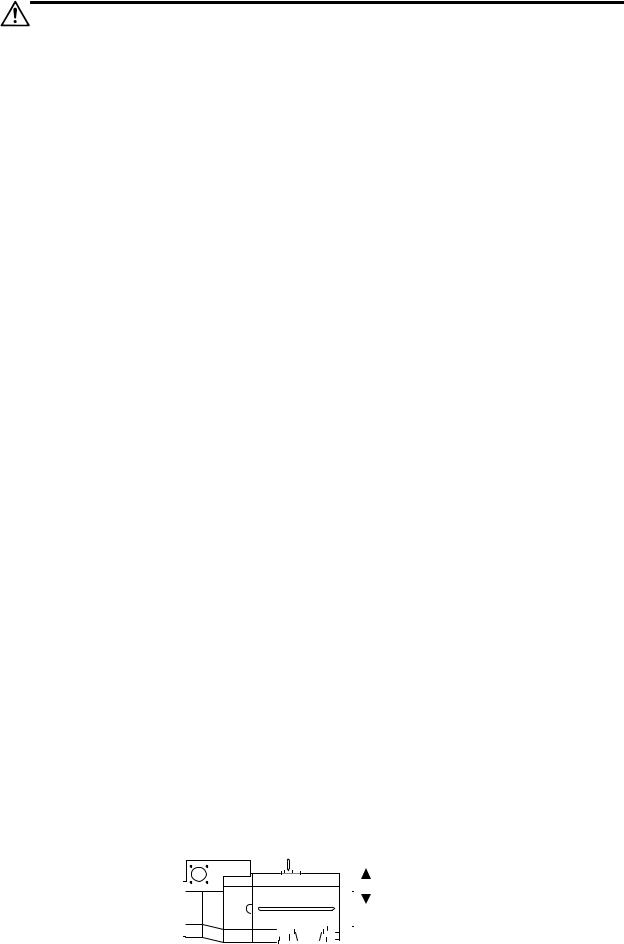
1. Installation
1-1 Installation of spindle motor
|
|
|
1. Do not hold the cables, axis or detector when transporting the motor. Failure to |
|||
|
|
|
|
observe this could lead to faults or injuries. |
||
|
|
|
2. Securely fix the motor to the machine. Insufficient fixing could lead to the |
|||
|
|
|
|
motor deviating during operation. Failure to observe this could lead to |
||
|
|
|
|
injuries. |
||
|
CAUTION |
3. When coupling to a servomotor shaft end, do not apply an impact by |
||||
|
|
hammering, etc. The detector could be damaged. |
||||
|
|
|
4. Never touch the rotary sections of the motor during operations. Install a |
|||
|
|
|
|
cover, etc., on the shaft. |
||
|
|
|
5. Do not apply a load exceeding the tolerable load onto the servomotor shaft. |
|||
|
|
|
|
The shaft could break. Failure to observe this could lead to injuries. |
||
|
|
|
6. Do not connect or disconnect any of the connectors while the power is ON. |
|||
|
|
|
|
|
||
1-1-1 Environmental conditions |
||||||
|
|
|
|
|
|
|
|
|
Environment |
|
Conditions |
|
|
|
|
|
|
|
|
|
|
|
Ambient temperature |
|
0°C to +40°C (with no freezing) |
|
|
|
|
Ambient humidity |
|
|
90%RH or less (with no dew condensation) |
|
|
|
Storage temperature |
|
-20°C to +65°C (with no freezing) |
|
|
|
|
Storage humidity |
|
|
90%RH or less (with no dew condensation) |
|
|
|
Atmosphere |
|
|
Indoors (Where unit is not subject to direct sunlight) |
|
|
|
|
|
No corrosive gases, flammable gases, oil mist or dust |
|
|
|
|
|
|
|
|
|
|
|
Altitude |
|
|
Operation/storage: 1000m or less above sea level |
|
|
|
|
|
Transportation: 10000m or less above sea level |
|
|
|
|
|
|
|
|
|
(Note) Refer to each spindle motor specifications for details on the spindle motor vibration conditions.
1-1-2 Shaft characteristics
There is a limit to the load that can be applied on the motor shaft. Make sure that the load applied on the radial direction, when mounted on the machine, is below the tolerable values given below. These loads also affect the motor output torque, so consider them when designing the machine.
|
|
|
Spindle motor |
|
|
|
|
|
Tolerable radial load |
||||||||||||||||||||||
|
|
|
|
|
|
|
|
|
|
|
|
|
|
|
|
|
|
|
|
|
|
|
|
|
|
|
|
|
|
|
|
SJ-V3.7-02ZM |
|
|
|
|
|
490 |
N |
||||||||||||||||||||||||
SJ-V2.2-01, SJ-V3.7-01 |
|
|
|
|
|
980 |
N |
||||||||||||||||||||||||
SJ-V7.5-03ZM, SJ-V11-06ZM |
|
|
|
|
|
||||||||||||||||||||||||||
|
|
|
|
|
|
|
|||||||||||||||||||||||||
SJ-V5.5-01, SJ-V11-08ZM |
|
|
|
|
|
1470 |
N |
||||||||||||||||||||||||
SJ-PMF01830-00 |
|
|
|
|
|
||||||||||||||||||||||||||
|
|
|
|
|
|
|
|||||||||||||||||||||||||
SJ-V7.5-01, SJ-V11-01 |
|
|
|
|
|
1960 |
N |
||||||||||||||||||||||||
SJ-V22-06ZM, SJ-V30-02ZM, SJ-PMF03530-00 |
|
|
|
|
|
||||||||||||||||||||||||||
|
|
|
|
|
|
|
|||||||||||||||||||||||||
SJ-V11-09, SJ-V15-01, SJ-V15-03, SJ-V18.5-01, SJ-V18.5-03 |
|
|
|
|
|
2940 |
N |
||||||||||||||||||||||||
SJ-V22-01, SJ-V22-05, SJ-V26-01, SJ-30A |
|
|
|
|
|
||||||||||||||||||||||||||
|
|
|
|
|
|
|
|||||||||||||||||||||||||
SJ-22XW5 |
|
|
|
|
|
3920 |
N |
||||||||||||||||||||||||
SJ-37BP |
|
|
|
|
|
4900 |
N |
||||||||||||||||||||||||
SJ-22XW8, SJ-45BP |
|
|
|
|
|
5880 |
N |
||||||||||||||||||||||||
SJ-V55-01 |
|
|
|
|
|
||||||||||||||||||||||||||
|
|
|
|
|
|
|
|||||||||||||||||||||||||
|
|
|
|
|
|
|
|
|
|
|
|
|
|
|
|
|
|
|
|
|
|
|
|
|
|
|
|
|
Radial load |
|
|
|
|
|
|
|
|
|
|
|
|
|
|
|
|
|
|
|
|
|
|
|
|
|
|
|
|
|
|
|
|
||
|
|
|
|
|
|
|
|
|
|
|
|
|
|
|
|
|
|
|
|
|
|
|
|
|
|
|
|
|
|
||
|
|
|
|
|
|
|
|
|
|
|
|
|
|
|
|
|
|
|
|
|
|
|
|
|
|
|
|
|
|
||
(Note) The load point is at the one-half of the shaft length.
1 - 2
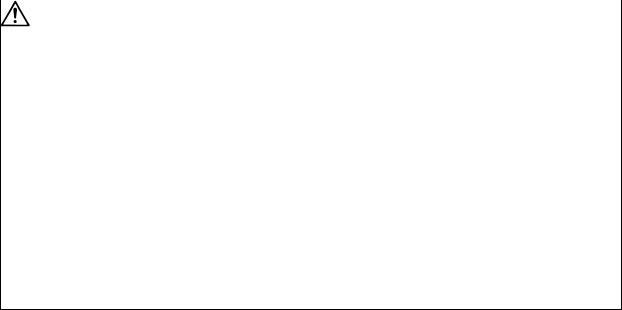
|
|
1. Installation |
1-2 Installation of the control unit |
||
|
|
|
1. |
Install the unit on noncombustible material. Direct installation on |
|
|
|
combustible material or near combustible materials may lead to fires. |
2. |
Follow the instructions in this manual and install the unit while allowing for |
|
|
|
the unit weight. |
3. |
Do not get on top of the units or motor, or place heavy objects on the unit. |
|
|
|
Failure to observe this could lead to injuries. |
4. |
Always use the unit within the designated environment conditions. |
|
5. |
Do not let conductive objects such as screws or metal chips, etc., or |
|
|
CAUTION 6. |
combustible materials such as oil enter the units. |
|
Do not block the units intake and outtake ports. Doing so could lead to |
|
|
|
failure. |
7. |
The units and servomotor are precision devices, so do not drop them or apply |
|
|
|
strong impacts to them. |
8. |
Do not install or run units or servomotor that is damaged or missing parts. |
|
9. |
When storing for a long time, please contact your dealer. |
|
10.Always observe the installation directions. Failure to observe this could lead to faults.
11.Secure the specified distance between the units and panel, or between the units and other devices. Failure to observe this could lead to faults.
1-2-1 Environmental conditions
Environment |
Conditions |
|
|
|
|
Ambient temperature |
0°C to +55°C (with no freezing) |
|
Ambient humidity |
90%RH or less (with no dew condensation) |
|
Storage temperature |
-15°C to +70°C (with no freezing) |
|
Storage humidity |
90%RH or less (with no dew condensation) |
|
Atmosphere |
Indoors (no direct sunlight); |
|
no corrosive gases, inflammable gases, oil mist, dust or conductive particles |
||
|
||
Altitude |
Operation/storage: 1000m or less above sea level |
|
Transportation: 10000m or less above sea level |
||
|
||
Vibration |
Operation/storage: 4.9m/s2 (0.5G) or less |
|
Transportation: 49m/s2 (5G) or less |
(Note) When installing the machine at 1,000m or more above sea level, the heat dissipation characteristics will drop as the altitude increases. The upper limit of the ambient temperature drops 1°C with every 100m increase in altitude. (The ambient temperature at an altitude of 2,000m is between 0 and 45°C.)
1 - 3
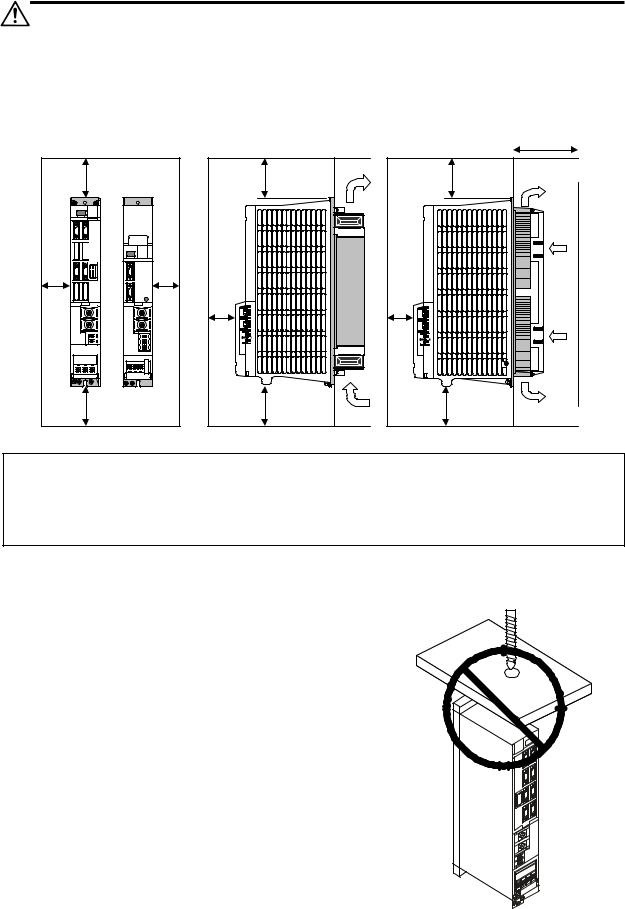
1. Installation
1-2-2 Installation direction and clearance
Wire each unit in consideration of the maintainability and the heat dissipation, as well as secure sufficient space for ventilation.
100mm or more
10mm 



 or
or  more
more 
100mm or more
|
|
75mm or more |
|
100mm or |
100mm or |
|
more |
more |
10mm |
|
|
or |
|
|
more |
50mm |
50mm |
|
||
|
or more |
|
|
or more |
|
|
|
|
|
100mm or |
100mm or |
|
more |
more |
The ambient temperature condition for the power supply unit or the drive units is
55°C or less. Because heat can easily accumulate in the upper portion of the
CAUTION units, give sufficient consideration to heat dissipation when designing the panel. If required, install a fan in the panel to agitate the heat in the upper portion of the
units.
1-2-3 Prevention of entering of foreign matter
Treat the cabinet with the following items.
• Make sure that the cable inlet is dust and oil proof by using packing, etc.
• Make sure that the external air does not enter inside by using head radiating holes, etc.
•Close all clearances.
•Securely install door packing.
•If there is a rear cover, always apply packing.
•Oil will tend to accumulate on the top. Take special measures such as oil-proofing to the top so that oil does not enter the cabinet from the screw holds.
•After installing each unit, avoid machining in the periphery. If cutting chips, etc., stick onto the electronic parts, trouble may occur.
•When using the unit in an area with toxic gases or high levels of dust, protect the unit with air purging (system to blow clean air so that the panel's inner pressure is higher than the outer pressure).
1 - 4
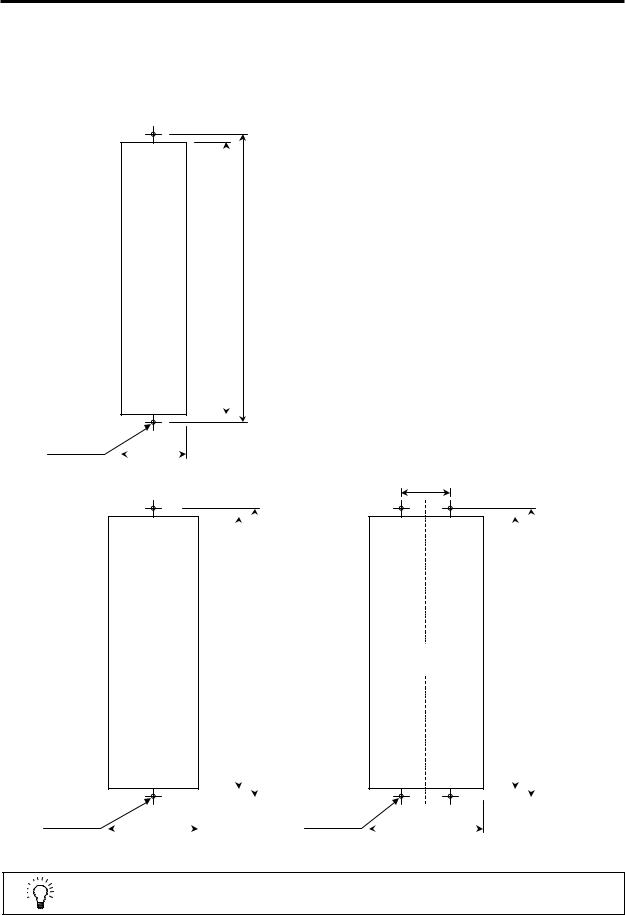
1. Installation
1-2-4 Panel installation hole work drawings (Panel cut drawings)
Prepare a square hole to match the unit width.
[Unit: mm]
Square hole (Note 1)
2-M5 screw |
82 |
|
|
|
|
Unit width: 90mm
342 |
360 |
|
|
|
|
|
|
|
60
Square hole (Note 1)
|
|
|
|
|
|
|
342 |
|
360 |
|
|
|
|
|
|||
|
|
|
|
|
|
|
|
|
|
|
|
|
|
|
|
|
|
Square hole (Note 1)
|
|
|
|
|
|
|
342 |
|
360 |
|
|
|
|
|
|||
|
|
|
|
|
|
|
|
|
|
|
|
|
|
|
|
|
|
2-M5 screw |
|
112 |
|
4-M5 screw |
|
142 |
|
|
Unit width: 120mm |
|
|
Unit width: 150mm |
|
POINT Attach packing around the square hole to provide a seal.
1 - 5
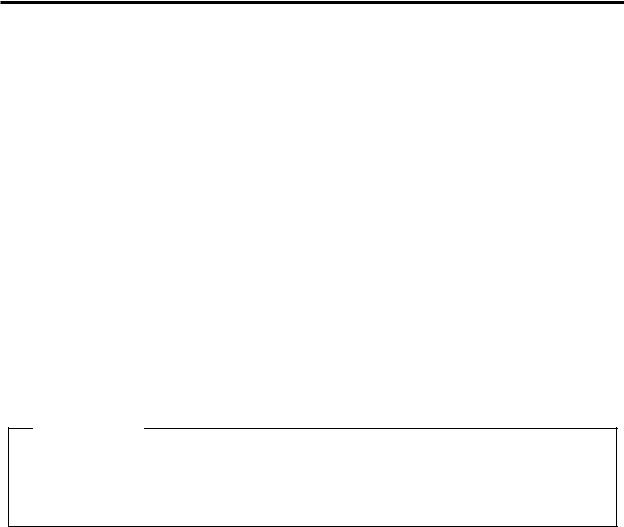
1. Installation
1-2-5 Heating value
Each heating value is calculated with the following values.
The values for the spindle drive unit are for a continuous rated output. The value for the power supply unit includes the AC reactor's heating value.
Servo drive unit |
Power supply unit |
||||||
|
Heating amount |
|
Heating amount |
||||
Type |
|
[W] |
Type |
|
[W] |
||
MDS-C1- |
Inside |
Outside |
MDS-C1- |
Inside |
|
Outside |
|
|
panel |
|
panel |
|
panel |
|
panel |
|
|
|
|
|
|
|
|
SPA55 |
31 |
|
76 |
CV37 |
21 |
|
34 |
SPA75 |
35 |
|
102 |
CV55 |
23 |
|
42 |
SPA-110 |
41 |
|
140 |
CV75 |
25 |
|
55 |
SPA-150 |
48 |
|
187 |
CV-110 |
26 |
|
99 |
SPA-185 |
62 |
|
280 |
CV-150 |
29 |
|
126 |
SPA-220 |
65 |
|
301 |
CV-185 |
33 |
|
162 |
SPA-260 |
80 |
|
403 |
CV-220 |
35 |
|
175 |
SPA-300 |
98 |
|
522 |
CV-260 |
40 |
|
220 |
|
|
|
|
CV-300 |
46 |
|
274 |
|
|
|
|
CV-370 |
54 |
|
346 |
(Example 1)
When using MDS-C1-CV-185, MDS-C1-SPA[]-185[] |
|
Total heating value = (33+162) + (62+280) |
Heating value in panel = (33) + (62) |
= 537 [W] |
= 95 [W] |
1 - 6
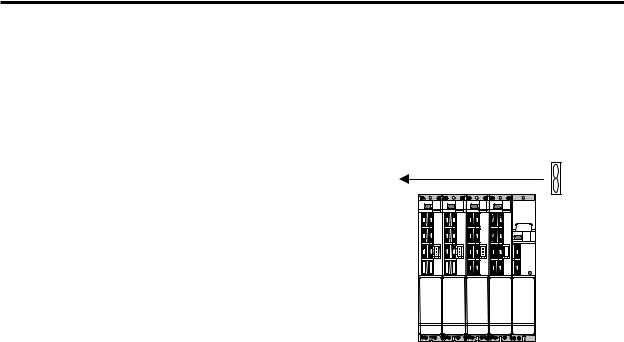
1. Installation
1-2-6 Heat radiation countermeasures
In order to secure reliability and life, design the temperature in the panel so that the ambient temperature of each unit is 55°C or less.
If heat accumulates at the top of the unit, etc., install a fan so that the temperature in the panel remains constant.
(Note) Due to the structure, heat easily accumulates at the top of the unit. Install a fan in the power distribution panel to circulate the heat at the top of the unit.
(Inside panel)
Wind speed 2m/s or more
Fan
1 - 7

1. Installation
Please refer to following method for heat radiation countermeasures.
Calculate total heat radiation of each mounted unit (W)
Calculate cabinet’s cooling capacity (W1)
W ≤ W1 |
Comparison of W and W1 |
|
|
|
|
|
|
W>W1 |
|
|
|
|
|
Selection of heat exchanger |
|
|
|
|
|
Mounting design |
Collection of internal temperature rise distribution data
∆T≤10°C
Evaluation
∆T>10°C
Improvements
Completion
<Hypothetical conditions> |
|
≤ |
|
|
(1) |
Average temperature in cabinet : T |
55°C |
||
(2) |
Cabinet peripheral temperature : Ta |
≤ |
0°C to 45°C |
|
(3) |
Internal temperature rise value |
: |
∆T=T–Tamax= 10°C |
|
|
|
|
|
|
<Supplement>
1)Refer to Specifications Manual, etc. for the heat generated by each unit.
2)Enclosed cabinet (thin steel plate) cooling capacity calculation equation
W1 = U × A × ∆T
U:6W/m2 × °C (with internal agitating fan) 4W/m2 × °C (without internal agitating fan)
A:Effective heat radiation area (m2) (Heat dissipation area in panel)
Sections contacting other objects are excluded.
∆T: Internal temperature rise value (10°C)
3)Points of caution for heat radiation countermeasures when designing mounting state
•Layout of convection in panel
•Collect hot air at suction port in heat exchanger cabinet.
4)Understanding the temperature rise distribution in the panel
∆T (average value) ≤ 10°C ∆Tmax (maximum value) ≤ 15°C
R (inconsistency) = (∆Tmax – ∆Tmin) ≤ 6°C (Evaluate existence of heat spots)
Examples of mounting and temperature measurement positions (reference)
z Measurement position (example)
Heat exchanger
Relay, etc |
Flow of air |
Unit |
Flow of air |
|
1 - 8

1. Installation
1-3 Installing the spindle detector
1-3-1 Magnetic sensor
(1) Installing the magnetic sensor
•Tolerance to shaft dimension should be "h6" on the part for installing a magnet.
•2-øG hole can be used for positioning of spindle and magnet.
•Magnet shall be installed as shown to the right.
•Misalignment between sensor head and magnetic center line shall be within ±2mm.
•There is an NS indication on the side of the cover. Install so that the reference notch on the sensor head comes to the case side.
(2)Gap between magnet and sensor
Reference notch |
|
Spindle |
|
|
|
|
G hole |
Case |
|
|
|
|
h6 |
Cover |
Gap |
|
|
|
Spindle damping screw |
|
|
|
|
Reference drawing for magnet installation |
||
|
|
|
|
Circumference installation |
|
|
|
|
|
|
|
|
|
Horizontal installation |
|
|
|
|||||||||||||||||||||||||||
|
|
|
|
|
|
|
|
|
|
|
|
|
|
|
|
|
|
|
|
|
|
|
|
|
|
|
|
|
|
|
|
|
|
|
|
|
|
|
|
|
|
|
|
|
|
|
|
|
|
|
|
|
|
|
|
|
|
|
|
Direction of |
|
|
|
|
|
|
|
|
|
|
|
|
|
|
|
|
Direction of |
||||||||||||
|
|
|
|
|
|
|
|
|
|
|
|
|
|
|
|
|
|
|
|
|
|
|
|
|
|
|
|
|
|
|
||||||||||||||
|
|
|
|
|
|
|
|
|
|
|
|
|
|
|
|
|
|
|
|
|
|
|
|
|
|
|
|
|
|
|
||||||||||||||
Spindle |
|
|
|
|
|
|
|
|
|
|
|
|
rotation |
|
Reference |
|
|
Spindle |
|
|||||||||||||||||||||||||
|
|
|
|
|
|
|
|
|
|
|
|
|
|
|
|
|
|
|
|
|
|
|
|
|
hole |
|
|
|
|
|
|
|
|
|
|
rotation |
||||||||
|
|
|
|
|
|
|
|
|
|
|
|
|
|
|
|
|
|
|
|
R |
|
Reference |
|
|
|
|
|
|
|
|
|
|
|
|
|
|
|
|
||||||
|
|
|
|
|
|
|
|
|
|
|
|
|
|
|
|
|
|
|
|
|
notch |
|
|
|
|
|
|
|
|
|
|
|
|
|
Face B |
|
R |
|||||||
|
|
|
|
|
|
|
|
|
|
|
|
|
|
|
|
Face A |
|
|
|
|
|
|
|
|
|
|
|
|
|
|
|
|||||||||||||
|
|
|
|
|
|
|
|
|
|
|
|
|
|
|
|
|
Face B |
|
|
|
|
|
|
|
|
|
|
|
|
|
||||||||||||||
|
|
|
|
|
|
|
Face A |
|
|
|
|
|
|
|
|
|
|
|
|
|
|
|
|
|
|
|
|
|
|
|
||||||||||||||
|
|
|
|
|
|
|
|
Reference |
S |
|
N |
|
|
|
|
|
|
|
|
|
|
|
|
|
|
|
|
|
|
|
S |
|
|
N |
|
|||||||||
|
|
|
|
|
|
|
|
|
|
|
|
|
|
|
|
|
|
|
|
|
|
|
|
|
|
|
|
|
|
|
|
|
||||||||||||
Magnet |
|
|
|
|
|
hole |
|
|
|
|
|
|
|
|
|
|
|
|
|
|
|
|
|
|
|
|
|
|
|
|
|
|
Magnet |
|
|
|
||||||||
|
|
|
|
|
Reference |
|
|
|
|
|
|
|
|
|
|
|
|
|
|
|
|
|
|
|
|
|
Gap |
|
|
Reference |
||||||||||||||
|
|
|
|
|
|
|
|
notch |
|
|
|
|
|
|
|
|
|
|
|
|
|
|
|
|
|
|
|
|
|
|
|
|
|
|
|
|
|
|
|
|
||||
|
|
|
|
|
|
|
|
|
|
|
|
Min. gap |
|
|
|
|
|
|
Max. gap |
|
|
|
|
|
|
|
|
|
|
|
|
|
Reference |
|
|
hole |
||||||||
|
|
|
|
|
|
|
|
|
|
|
|
|
|
|
|
|
|
Mounting plate |
|
|
|
|
|
|
|
|
|
|
|
|
|
|
|
|
||||||||||
|
|
|
|
|
|
|
|
|
|
|
|
|
|
|
|
|
|
|
|
|
|
|
|
|
|
|
|
|
|
|
notch |
|
|
|
||||||||||
|
|
|
|
|
|
|
|
|
|
|
|
|
|
|
|
|
|
|
|
|
|
|
|
|
|
|
|
|
|
|
|
|
|
|
|
|
|
|
|
|
||||
|
|
|
|
|
|
|
|
|
|
|
|
|
|
|
|
|
|
|
|
|
|
|
|
|
|
|
|
|
|
|
|
|
|
|
|
|
|
|
|
|
|
|
|
|
|
|
|
|
|
|
|
|
|
|
|
|
|
|
|
|
|
|
|
|
|
|
|
|
|
|
|
|
|
|
|
|
|
|
|
|
|
|
|
|
|
|
|
|
|
Magnet |
|
|
|
|
|
|
BKO-C1810H03 |
|
BKO-C1730H06 |
|
BKO-C1730H09 |
|||||||||||||||||||||||||||||||||
model |
|
|
|
|
|
|
|
|
||||||||||||||||||||||||||||||||||||
|
|
|
|
|
|
|
|
|
|
|
|
|
|
|
|
|
|
|
|
|
|
|
|
|
|
|
|
|
|
|
|
|
|
|
|
|
|
|
|
|
||||
Installation |
|
|
|
Circumference |
|
|
|
Horizontal |
Circumference |
|
Horizontal |
Circumference |
||||||||||||||||||||||||||||||||
direction |
|
|
|
installation |
|
|
|
installation |
installation |
|
installation |
installation |
||||||||||||||||||||||||||||||||
R (Radius) |
|
|
|
|
|
|
|
|
Gap mm |
|
|
|
|
|
|
|
|
|
|
|
Gap mm |
|
|
|
|
|
|
|
Gap mm |
|||||||||||||||
mm |
Max. value |
|
Min. value |
|
|
|
|
|
|
Max. value |
Min. value |
|
|
|
|
|
Max. value |
|
Min. value |
|||||||||||||||||||||||||
|
|
|
|
|
|
|
|
|
|
|
|
|
|
|
|
|
||||||||||||||||||||||||||||
|
|
|
|
|
|
|
|
|
|
|
|
|
|
|
|
|
|
|
|
|
|
|
|
|
|
|
|
|
|
|
|
|
|
|
|
|
|
|
|
|
|
|
|
|
|
|
|
|
|
|
|
|
|
|
|
|
|
|
|
|
|
|
|
|
|
|
|
|
|
|
|
|
|
|
|
|
|
|
|
|
|
|
|
|
|
|
|
||
40 |
|
11.5±0.5 |
|
|
|
2.7±0.5 |
|
|
|
6.0±0.5 |
10.0±0.5 |
1.22±0.5 |
|
5.0±0.5 |
|
6.25±0.5 |
3.30±0.5 |
|||||||||||||||||||||||||||
50 |
|
9.5±0.5 |
|
|
|
2.8±0.5 |
|
|
|
6.0±0.5 |
8.0±0.5 |
1.31±0.5 |
|
5.0±0.5 |
|
6.00±0.5 |
3.70±0.5 |
|||||||||||||||||||||||||||
60 |
|
8.5±0.5 |
|
|
|
3.0±0.5 |
|
|
|
6.0±0.5 |
7.0±0.5 |
1.50±0.5 |
|
5.0±0.5 |
|
5.75±0.5 |
3.85±0.5 |
|||||||||||||||||||||||||||
70 |
|
8.0±0.5 |
|
|
|
3.4±0.5 |
|
|
|
|
|
|
|
|
|
7.0±0.5 |
2.38±0.5 |
|
|
|
|
|
|
5.50±0.5 |
3.87±0.5 |
|||||||||||||||||||
1 - 9
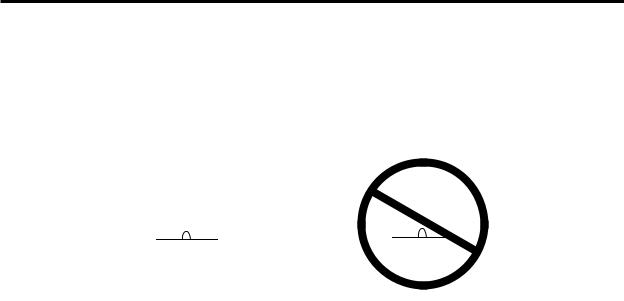
1.Installation
(3)Magnet and sensor installation directions
•Install so that the magnet's reference hole and sensor's reference notch are aligned. (Standard/high-speed standards)
•Install so that the magnet's N pole comes to the left side when the sensor's reference notch is faced downward. (High-speed compact/high-speed ring)
|
|
|
|
|
|
|
|
N |
Sensor |
S |
|
S |
|
Sensor |
N |
|
|
|
|
|
|
|
|
|
|
|
|
|
|
|
|
|
|
|
|
|
|
|
Magnet |
|
| |
Magnet |
|
| |
|
||
|
|
|
|
|
|
||
Reference notch |
Reference notch |
||||||
(4)Cautions
[1]Do not apply impacts on the magnet. Do not install strong magnets near the magnet.
[2]Sufficiently clean the surrounding area so that iron chips and cutting chips do not adhere to the magnet. Demagnetize the round disk before installing.
[3]Securely install the magnet onto the spindle with an M4 screw. Take measures to prevent screw loosening as required.
[4]Balance the entire spindle rotation with the magnet installed.
[5]Install a magnet that matches the spindle's rotation speed.
[6]When installing the magnet onto a rotating body's plane, set the speed to 6,000r/min or less.
[7]Install so that the center line at the end of the head matches the center of the magnet.
[8]The BKO-C1730 is not an oil-proof product. Make sure that oil does not come in contact with BNO-C1730 or BKO-C1810.
[9]When connecting to the spindle drive unit, wire so that the effect of noise is suppressed.
1 - 10

1. Installation
1-3-2 Spindle side detector
When coupling the spindle side detector with spindle, a flexible coupling should be used to couple the spindle side detector with the spindle.
Flexible coupling
Opposite detector shaft side 
Detector |
0.02 |
0.02 |
Detector and coupling installation accuracy
Recommended coupling
|
|
Recommendation 1 |
Recommendation 2 |
|
|
|
|
|
|
Manufacturer |
Tokushu Seiko |
Eagle |
||
Model |
Model M1 |
FCS38A |
||
Resonance frequency |
1374Hz |
3515Hz |
||
Position detection error |
0.8×10-3° |
1.2×10-3° |
||
Tolerable speed |
20000r/min |
10000r/min |
||
Mis-alignment |
Core deviation |
0.7mm |
0.16mm |
|
Angle displacement |
1.5° |
1.5° |
||
|
||||
Outline dimensions |
Max. length |
74.5mm |
33mm |
|
Max. diameter |
ø57mm |
ø38mm |
||
|
||||
Refer to the coupling catalog, etc., for details on the coupling.
1 - 11
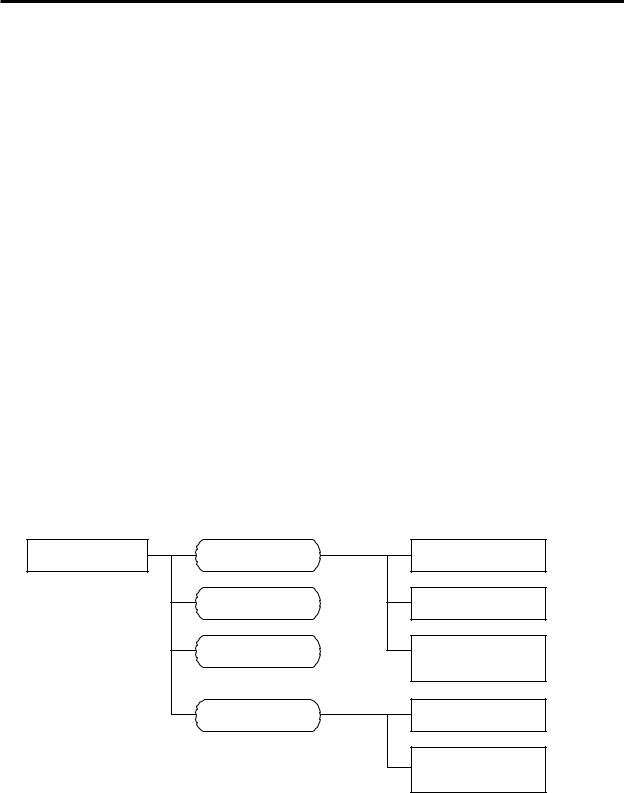
1. Installation
1-4 Noise measures
Noise includes "propagation noise" generated from the power supply or relay, etc., and propagated along a cable causing the power supply unit or drive unit to malfunction, and "radiated noise" propagated through air from a peripheral device, etc., and causing the power supply unit or drive unit to malfunction.
Always implement these noise measures to prevent the peripheral devices and unit from malfunctioning. The measures differ according to the noise propagation path, so refer to the following explanation and take appropriate measures.
(1)General noise measures
•Avoid laying the drive unit's power line and signal wire in a parallel or bundled state. Always separate these wires. Use a twisted pair shielded wire for the detector cable and signal wires such as the communication cable connected with the NC, and accurately ground the devices.
•Use one-point grounding for the drive unit and motor.
•Accurately ground the AC reactor.
(2)Propagation noise measures
Take the following measures when noise generating devices are installed and the power supply unit or drive unit could malfunction.
•Install a surge killer on devices (magnetic contacts, relays, etc.) which generate high levels of noise.
•Install a power line filter in the stage before the power supply unit.
•Install a ferrite core on the signal wire.
•Ground the shield of the servo detector's cable with a cable clamp.
•Wire the spindle PLG detector cable away from other wires.
(3)Measures against radiated noise
The types of propagation paths of the noise and the noise measures for each propagation path are shown below.
Noise generated from |
Airborne |
|
drive unit |
propagation noise |
|
|
Magnetic induction |
Path [4] |
|
noise |
|
|
and [5] |
|
|
|
|
|
Static induction |
Path [6] |
|
noise |
|
|
|
|
|
Cable propagation |
|
|
noise |
|
Noise directly radiated from drive unit
Noise radiated from power line
Noise radiated from spindle motor
Noise propagated over power line
Noise lead in from grounding wire by leakage current
Path [1]
Path [2]
Path [3]
Path [7]
Path [8]
1 - 12
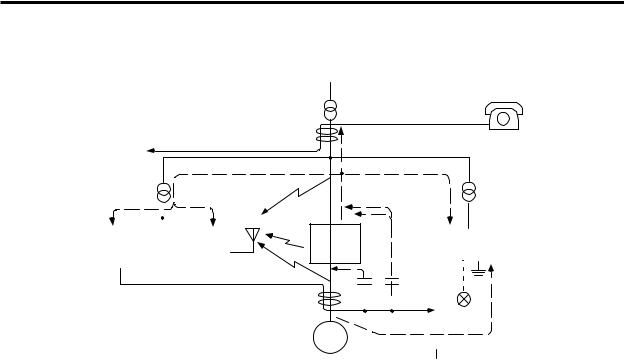
1. Installation
[5]
|
|
|
|
|
|
|
|
|
|
|
|
|
|
|
|
|
|
|
|
|
|
|
|
[7] |
|
|||
|
|
|
[7] |
[2] |
|
|
|
|
|
|
|
|
|
|
|
|
|
|
|
|
|
|
|
|||||
|
|
|
|
|
|
|
|
|
[1] |
|
|
|
[2] |
|
|
|
|
|
|
|
|
|
|
|||||
|
|
|
|
|
|
|
|
|
|
|
|
|
|
|
|
|
|
|
|
|
|
|
|
|
|
|
|
|
|
|
|
|
|
|
|
|
|
|
|
|
|
|
|
|
|
|
|
|
|
|
|
|
|
|
|
|
|
|
|
|
|
|
|
|
|
|
|
|
|
|
|
|
|
|
|
|
|
|
|
|
|
|
|
|
|
|
|
Instru- |
|
|
|
|
|
|
|
Drive |
|
|
|
|
|
|
|
|
|
|
|
|
|
|
Sensor |
|
|||
|
|
|
|
Receiver |
|
|
|
|
|
|
|
|
|
|
|
|
|
|
|
power |
|
|||||||
|
ment |
|
|
|
|
unit |
|
|
|
|
|
|
|
|
|
|
|
|
|
|
|
|||||||
|
|
|
|
|
|
|
[3] |
[6] |
|
|
|
|
|
|
|
|
|
|
|
supply |
|
|||||||
|
|
|
|
|
|
|
|
|
|
|
|
|
|
|
|
|
|
|
|
|
|
|
|
|
||||
|
|
|
|
|
|
|
|
|
[4] |
[8] |
||||||||||||||||||
|
|
|
|
|
|
|
|
|
|
|
|
|
|
|
|
|
|
|
|
|
||||||||
|
|
|
|
|
|
|
|
|
|
|
|
|
|
|
|
|
|
|
|
|
||||||||
|
|
|
|
|
|
|
|
|
Spindle motor |
M |
|
|
|
|
|
|
|
|
|
|
|
|
|
|
|
|
Sensor |
|
|
|
|
|
|
|
|
|
|
|
|
|
|
|
|
|
|
|
|
|
|
|
|
|
|
||||
|
|
|
|
|
|
|
|
|
|
|
|
|
|
|
|
|
|
|
|
|
|
|
|
|
||||
|
|
|
|
|
|
|
|
|
|
|
|
|
|
|
|
|
|
|
|
|
|
|
|
|
|
|
||
|
|
|
|
|
|
|
|
|
|
|
|
|
|
|
|
|
|
|
|
|
|
|
|
|
|
|
||
|
|
|
|
|
|
|
|
|
|
|
|
|
|
|
|
|
|
|
|
|
|
|
|
|
|
|
||
|
|
|
|
|
|
|
|
|
|
|
|
|
|
|
|
|
|
|
|
|
|
|
|
|
|
|||
|
|
|
|
|
|
|
|
|
|
|
|
|
|
|
|
|
|
|
|
|
|
|
|
|
|
|||
|
|
|
|
|
|
|
|
|
Generated noise of drive system |
|
|
|
|
|
||||||||||||||
|
|
|
|
|
|
|
|
|
|
|
|
|
|
|
|
|
|
|||||||||||
Noise propagation path |
|
|
|
|
|
|
|
|
|
|
|
Measures |
|
|
|
|
|
|||||||||||
|
|
|
|
|
||||||||||||||||||||||||
|
|
|
|
When devices such as instrument, receiver or sensor, which handle minute signals and are easily |
||||||||||||||||||||||||
|
|
|
|
affected by noise, or the signal wire of these devices, are stored in the same panel as the drive |
||||||||||||||||||||||||
|
|
|
|
units and the wiring is close, the device could malfunction due to airborne propagation of the noise. |
||||||||||||||||||||||||
|
|
|
|
In this case, take the following measures. |
|
|
|
|
|
|
|
|
|
|
|
|
|
|
|
|
||||||||
[1] [2] [3] |
|
|
|
(a) Install devices easily affected as far away from the drive units as possible. |
||||||||||||||||||||||||
|
|
|
(b) Lay devices easily affected as far away from the signal wire of the drive unit as possible. |
|||||||||||||||||||||||||
|
|
|
|
|
||||||||||||||||||||||||
|
|
|
|
|
(c) Avoid laying the signal wire and power line in a parallel or bundled state. |
|||||||||||||||||||||||
|
|
|
|
|
(d) Insert a line noise filter on the input/output wire or a radio filter on the input to suppress the |
|||||||||||||||||||||||
|
|
|
|
|
|
|
noise radiated from the wires. |
|
|
|
|
|
|
|
|
|
|
|
|
|
|
|
|
|||||
|
|
|
|
|
(e) Use a shield wire for the signal wire and power line, or place in separate metal ducts. |
|||||||||||||||||||||||
|
|
|
|
If the signal wire is laid in parallel to the power line, or if it is bundled with the power line, the noise |
||||||||||||||||||||||||
|
|
|
|
could be propagated to the signal wire and cause malfunction because of the magnetic induction |
||||||||||||||||||||||||
|
|
|
|
noise or static induction noise. In this case, take the following measures. |
||||||||||||||||||||||||
[4] [5] [6] |
|
|
|
(a) Install devices easily affected as far away from the drive unit as possible. |
||||||||||||||||||||||||
|
|
|
|
|
(b) Lay devices easily affected as far away from the signal wire of the drive unit as possible. |
|||||||||||||||||||||||
|
|
|
|
|
(c) Avoid laying the signal wire and power line in a parallel or bundled state. |
|||||||||||||||||||||||
|
|
|
|
|
(d) Use a shield wire for the signal wire and power line, or place in separate metal ducts. |
|||||||||||||||||||||||
|
|
|
|
If the power supply for the peripheral devices is connected to the power supply in the same system |
||||||||||||||||||||||||
|
|
|
|
as the drive units, the noise generated from the power supply unit could back flow over the power |
||||||||||||||||||||||||
[7] |
|
|
|
line and cause the devices to malfunction. In this case, take the following measures. |
||||||||||||||||||||||||
|
|
|
|
|
(a) Install a radio filter on the power supply unit's power line. |
|||||||||||||||||||||||
|
|
|
|
|
(b) Install a power filter on the power supply unit's power line. |
|||||||||||||||||||||||
|
|
|
|
If a closed loop is created by the peripheral device and drive unit's grounding wire, a leakage |
||||||||||||||||||||||||
[8] |
|
|
|
current could flow and cause the device to malfunction. |
|
|
|
|
|
|||||||||||||||||||
|
|
|
|
In this case, change the device grounding methods and the grounding place. |
||||||||||||||||||||||||
1 - 13
2. Wiring and Connection
2-1 Connection diagram ........................................................................................................................... |
2-3 |
||
2-1-1 Part system connection diagram.................................................................................................. |
2-3 |
||
2-1-2 Detailed connection diagram........................................................................................................ |
2-4 |
||
2-2 |
Main circuit terminal block/control circuit connector .......................................................................... |
2-7 |
|
2-2-1 |
Names and applications of main circuit terminal block signals and control circuit connectors .. |
2-7 |
|
2-2-2 |
Connector pin assignment .......................................................................................................... |
2-8 |
|
2-3 |
Drive unit connection........................................................................................................................ |
2-11 |
|
2-4 |
Motor and detector connection ........................................................................................................ |
2-14 |
|
2-4-1 |
Connection of the spindle motor ............................................................................................... |
2-14 |
|
2-5 |
Connection of power supply............................................................................................................. |
2-17 |
|
2-5-1 |
Power supply input connection ................................................................................................. |
2-17 |
|
2-5-2 |
Connecting the grounding cable ............................................................................................... |
2-20 |
|
2-5-3 |
Main circuit control .................................................................................................................... |
2-21 |
|
2-6 |
Peripheral control wiring................................................................................................................... |
2-23 |
|
2-6-1 |
Input interface............................................................................................................................ |
2-23 |
|
2-6-2 |
Output interface......................................................................................................................... |
2-25 |
|
2-6-3 |
Spindle coil changeover ............................................................................................................ |
2-27 |
|
2-6-4 |
Wiring of an external emergency stop....................................................................................... |
2-30 |
|
2 - 1
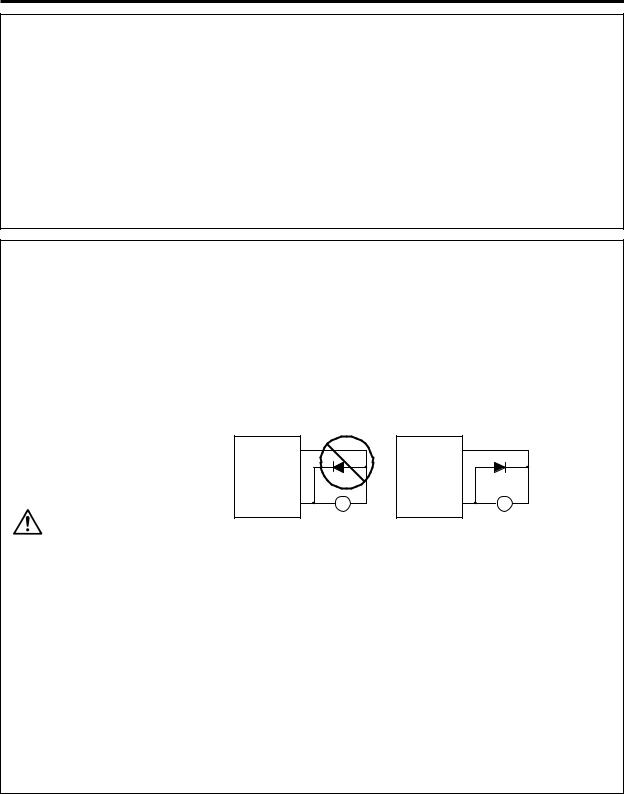
2.Wiring and Connection
1.Wiring work must be done by a qualified technician.
2.Wait at least 15 minutes after turning the power OFF and check the voltage with a tester, etc., before starting wiring. Failure to observe this could lead to electric shocks.
3.Securely ground the drive units and spindle motor.
|
|
|
4. Wire the drive units and spindle motor after installation. Failure to observe this |
|
|
DANGER |
|
|
|
|
could lead to electric shocks. |
|
|
|
|
|
|
|
5.Do not damage, apply forcible stress, place heavy items on the cables or get them caught. Failure to observe this could lead to electric shocks.
6.Always insulate the power terminal connection section. Failure to observe this could lead to electric shocks.
1.Correctly and securely perform the wiring. Failure to do so could result in runaway of the spindle motor or injury.
2.Do not mistake the terminal connections.
Failure to observe this item could lead to ruptures or damage, etc.
3.Do not mistake the polarity ( + , - ). Failure to observe this item could lead to ruptures or damage, etc.
4.Do not mistake the direction of the diodes for the surge absorption installed on the DC relay for the general-purpose output and contactor (magnetic contactor) control. The signal might not be output when a failure occurs.
Servodrive unit |
Servodrive unit |
COM |
|
COM |
|
|
(24VDC) |
|
(24VDC) |
|
|
Control output |
RA |
Control output |
RA |
|
signal |
signal |
|||
|
|
|||
CAUTION |
|
|
|
5.Electronic devices used near the drive units may receive magnetic obstruction. Reduce the effect of magnetic obstacles by installing a noise filter, etc.
6.Do not install a phase advancing capacitor, surge absorber or radio noise filter on the power line (U, V, W) of the spindle motor.
7.Do not modify this unit.
8.The half-pitch connector (CN10, etc.) on the front of the drive units have the same shape. If the connectors are connected incorrectly, faults could occur. Make sure that the connection is correct.
9.When grounding the motor, connect to the protective grounding terminal on the drive units, and ground from the other protective grounding terminal. (Use one-point grounding) Do not separately ground the connected motor and drive unit as noise could be generated.
2 - 2
